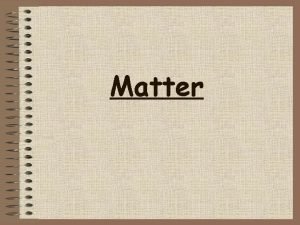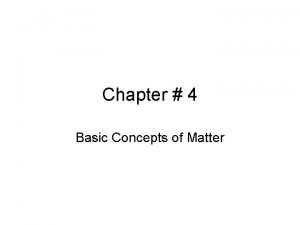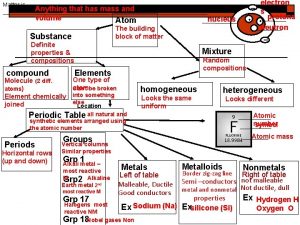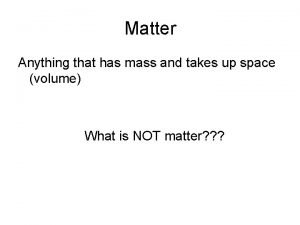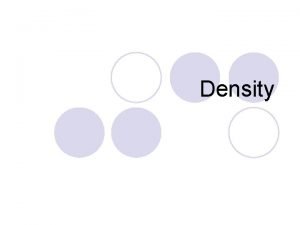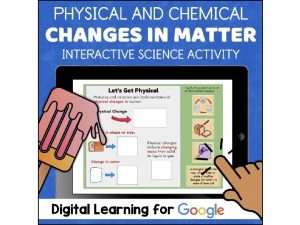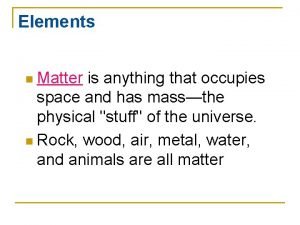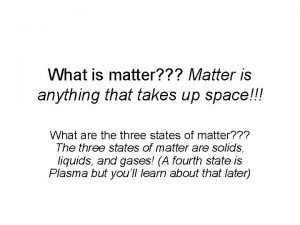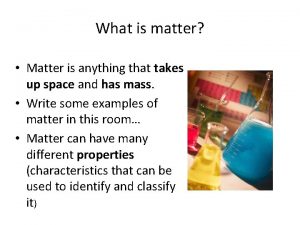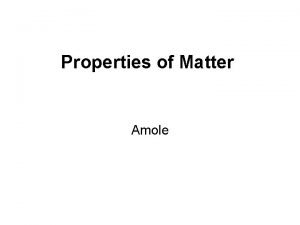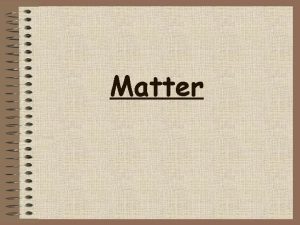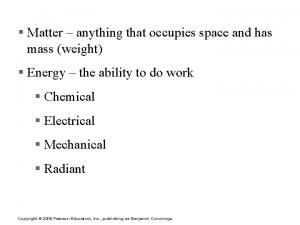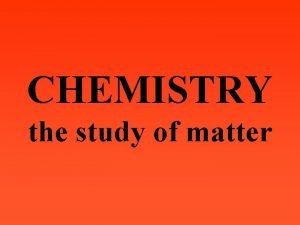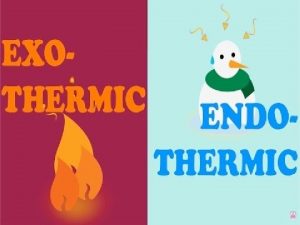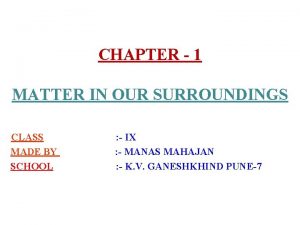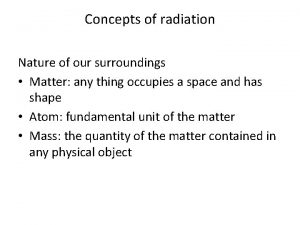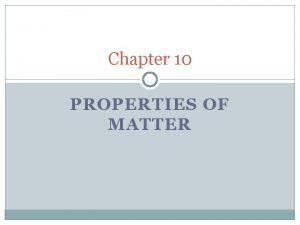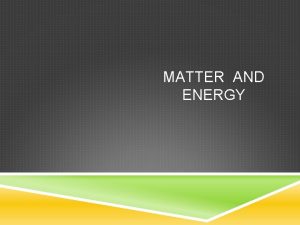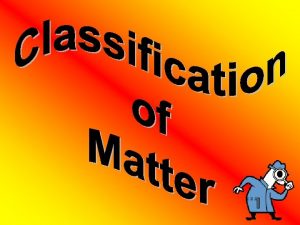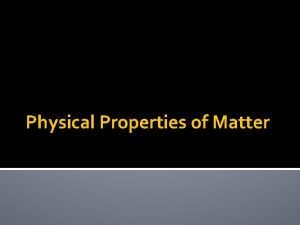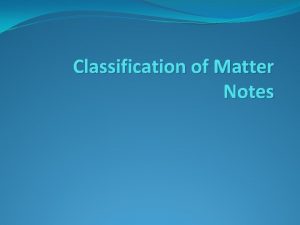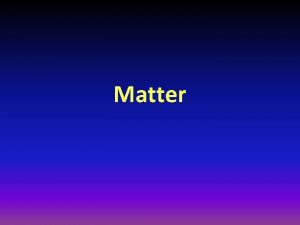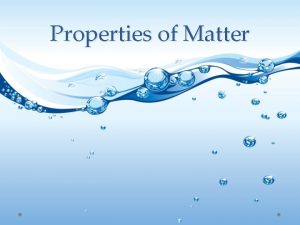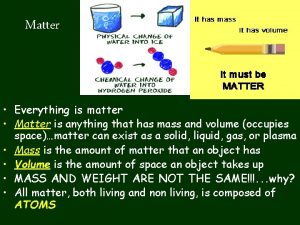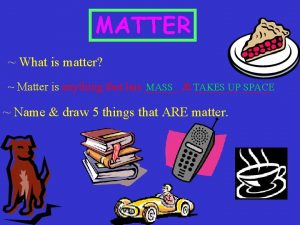MATTER IN OUR SURROUNDINGS Matter is anything which


























- Slides: 26

MATTER IN OUR SURROUNDINGS

Matter is anything which occupies space and has mass is called matter. Air and water, sugar and sand, hydrogen and oxygen etc. Classification of matter : • Early Indian philosophers classified in the form of five basic elements as air, earth, fire, sky and water called Panch Tatva. • On the basis of the physical state matter is classified as solids, liquids and gases. • On the basis of chemical composition matter is classified as pure substances and mixtures. • Pure substances may be elements or compounds. • Mixtures may be homogeneous mixtures or heterogeneous mixtures.

Characteristics of Particles of Matter Particles of matter have three characteristics: 1. Particles of matter have spaces between them 2. Particles of matter are moving all the time 3. Particles of matter attract each other a) Particles of Matter have spaces between them: Activity : - Take some water in a beaker and note its level. Dissolve some salt or sugar in it with the help of a glass rod. The salt dissolves in the water but the level of water does not change. This is because the particles of water get into the space between the particles of water. This shows that matter is made up of particles and have space between them.

b) The particles of matter are very tiny : Activity : - Dissolve 2 – 3 crystals of cobalt nitrate in 100 ml of water in a beaker. Take 10 ml of this solution and dissolve in 100 ml of water. Repeat this process 5 – 6 times. This shows that a few crystals of cobalt nitrate can colour a large volume of water because there are millions of tiny particles in each crystal. 10 ml I 00 ml 10 ml 100 ml

c) Particles of matter are continuously moving : Activity : - Take some water in a beaker and put a drop of blue or red ink slowly along the sides of the beaker. Leave it undisturbed for a few hours. The ink spreads evenly throughout the water. This happens because the tiny particles of water collide with tiny particles of ink. Due to these collisions, particles of water and ink mix with each other. The intermixing of two or more different types of matter on their own is called diffusion.

d) Particles of matter attract each other : Activity : - Take an iron nail, a piece of chalk and a rubber band. Try breaking them by hammering, cutting or stretching. It is more easier to break the chalk, less easier to break the rubber band difficult to break the iron nail. This is because in iron, the force of attraction between particles is maximum as particles are closer whereas in others they are not so close.

States of matter Matter is divided into 3 types: . They are : - i) Solid ii) Liquid iii) Gas Properties of solids : i) Solids have definite shapes and fixed volume. ii) The space between the particle is minimum. iii)The force of attraction between the particles is maximum. iv)The movement of the particles is minimum. v) They are least compressible. vi)Their rate of diffusion is least.

b) Properties of liquids : - i) Liquids have no definite shape but have fixed volume. Liquids take the shape of the container. ii) The space between the particles is intermediade. iii)The force of attraction between the particles is intermediate. iv)The movement of the particles is intermediate. v) They are less compressible. vi)Their rate of diffusion is more than solids.

C) Properties of gases : - i) Gases have no definite shape or fixed volume. Gases occupy the whole space of the container. ii) The space between the particles is maximum. iii)The force of attraction between the particles is minimum. iv)The movement of the particles is maximum. v) They are most compressible. vi)Their rate of diffusion is more than solids and liquids.


COMPARISON OF PROPERTIES

Change of state : • When a solid is heated it changes into liquid. When a liquid is heated it changes into gas. • When a gas is cooled it changes to liquid. When a liquid is cooled it changes into solid. Eg: - If ice is heated it changes into water. If water is heated it changes into steam. If steam is cooled it changes into water. If water is cooled it changes into ice. Solid state Heat Cool Liquid state Heat Cool Gaseous state

Melting (Fusion) : • When a solid is heated, the particles begin to vibrate with greater speed and begin to move more freely. Then at a particular temperature the solid melts and changes into liquid. The process of melting is also known as fusion. • The temperature at which a solid melts is called its melting point. The melting point of ice is 00 C or 273 K. Latent heat of fusion : The amount of heat energy that is required to change 1 kg of a solid into liquid at atmospheric pressure at its melting point is known as the latent heat of fusion. So, particles in water at 00 C (273 K) have more energy as compared to particles in ice at the same temperature.

Boiling : • When a liquid is heated, its particles begin to move even faster. Then at a particular temperature the liquid begins to boil and changes into gas (vapour). • Boiling is a bulk phenomenon. When a liquid boils the bulk of the liquid changes into vapour. • The temperature at which a liquid starts boiling is called its boiling point. The boiling point of water is 1000 C. Latent heat of vaporisation : The amount of heat energy that is required to change 1 kg of a liquid into gas at atmospheric pressure at its boiling point is known as the latent heat of vaporisation.


Measurement of Temperature Different units can be used to measure the temperature in different scales. Most known units of measurements are Kelvin and Degree Celsius. Kelvin : • Kelvin is the SI unit of temperature. The symbol of Kelvin is ‘K’. • The scale of Kelvin is used widely because of its many advantages over degree Celsius. In Kelvin scale, temperatures are written in positive usually. • At Kelvin scale -273 K is considered as the absolute zero temperature. Degree Celsius: • Degree Celsius is written as “o. C” and read as degree Celsius. Temperature in K = Temperature in o. C + 273

Sublimation : Sublimation is a process in which a solid changes directly into gas. Deposition is the change of gaseous state directly to solid state without going through liquid state. Sublimation of ammonium chloride is explained below: • Take some crushed ammonium chloride (solid) in a china dish. • There is an inverted funnel over the china dish. • There is a cotton plug on the stem of the funnel. • Heat the crushed ammonium chloride, we found that ammonium chloride directly changes into vapours. • After some time, we see that vapours of ammonium chloride again solidified at the surface of funnel.

Effect of pressure on gases When pressure is applied on gas the particles come closer and the gas changes into liquid. We can liquefy gases by applying pressure and reducing the temperature. Compressed solid carbon dioxide is called dry ice. If the pressure is reduced it changes directly to gas without coming into liquid state. So solid carbon dioxide is known as dry ice.

Interconversion of the three states of matter The states of matter are inter convertible. The state of matter can be changed by changing the temperature or pressure. n io Su bli ma tio n Su b on si Fu t ca ifi lid So lim ati on Solid Vaporisation Gas Liquid Condensation

Evaporation The change of a liquid into vapour at any temperature below its boiling point is called evaporation. Evaporation is a surface phenomenon. Particles from the surface gain enough energy to overcome the forces of attraction and changes to vapour state. Factors affecting evaporation : The rate of evaporation depends upon surface area, temperature, humidity and wind speed. Increase in the surface area increases the rate of evaporation. Increase in temperature increases the rate of evaporation. Increase in humidity decreases the rate of evaporation. Increase in wind speed increases the rate of evaporation.


Evaporation causes cooling Liquid needs heat for evaporation. It takes this heat from things in its surroundings. It means things in surrounding loose heat and thus they cool down. Eg Earthen Pot (Pitcher): The earthen pot has minute pores through which water sips out and droplets of water deposit on outer surface of pot. When this water evaporates, it takes latent heat from pot and water inside. So water inside cools down. Tea in Saucer: When tea is put in saucer, evaporation is faster due to more surface area. This cools tea faster and makes it easier to drink. Cotton Clothes in summer: Cotton absorbs water and thus sweats very fast. So sweat comes outside clothes in contact with atmosphere. Then it evaporates and gives cooling. Cooler: Cooler works on the concept of evaporation. When humidity is high, evaporation is very slow and thus cooler is ineffective. But in areas of low humidity, evaporation is fast and thus cooler is effective. Sweating: When we sweat; water in it; evaporates taking latent heat from our body. This cause cooling.


The Four & Five States of Matter Scientists have discovered that there are two more states of matter – • Plasma • Bose-Einstein Condensate Plasma: • It is a state of matter in which the particles are super excited and super energetic. They are in the form of ionized gases. • For Example – Fluorescent tubes and neon light bulbs consist of plasma • The neon bulbs contain neon gas and there is another gas such as helium in the fluorescent tube. As electricity is passed in the tube or the bulb, these gases get ionized and this creates the plasma inside them that glows. • In fact, the Sun and the stars glow because they plasma is present in them. Here are some examples of Plasma: Bose-Einstein Condensate (BEC): • It is the fifth state of matter discovered by Albert Einstein on the basis of the studies conducted by an Indian scientist Satyendra Nath Bose. • BEC is formed by condensing gases of extremely low densities to much lower temperatures.


Thank You
 Thinking affects our language which then affects our
Thinking affects our language which then affects our Matter vs mass
Matter vs mass Anything that has mass
Anything that has mass Is anything that has mass and takes up space.
Is anything that has mass and takes up space. Has mass and occupies space
Has mass and occupies space Matter is defined as anything that
Matter is defined as anything that Compare and contrast template
Compare and contrast template Anything that takes up space
Anything that takes up space What are the 7 diatomic elements
What are the 7 diatomic elements Matter is anything that occupies
Matter is anything that occupies Is matter anything that has mass
Is matter anything that has mass Matter anything that
Matter anything that Matter is anything that...
Matter is anything that... Matter is anything that has both
Matter is anything that has both Anything that occupies space
Anything that occupies space Matter is anything that:
Matter is anything that: Matter is anything that:
Matter is anything that: No matter anything
No matter anything Matter is anything that
Matter is anything that Matter anything that
Matter anything that Anything that has mass and takes up space is
Anything that has mass and takes up space is Matter anything that
Matter anything that Benjamin cummings
Benjamin cummings Matter anything that
Matter anything that Matter anything that
Matter anything that Be aware of your surroundings safety talk
Be aware of your surroundings safety talk Is baking bread endothermic or exothermic
Is baking bread endothermic or exothermic


